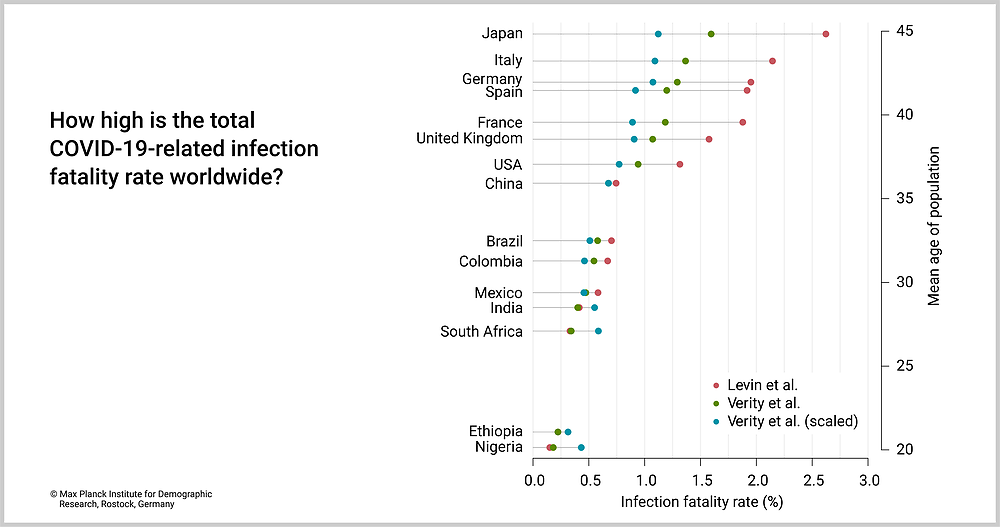April 14, 2020 | Press Release
Demographic Research about the Corona Pandemic: This is what scientists at MPIDR are investigating
Latest update: December 8, 2020

Because of the corona pandemic, people all over the world are only going outside while wearing face masks. © iStockphoto.com/Powerofflowers
In short statements, scientists from the Max Planck Institute for Demographic Research (MPIDR) explain the issues they are currently investigating in connection with the Covid-19 pandemic.
December 8, 2020
How to use Facebook Surveys to Learn More about People’s Health Behavior

André Grow © MPIDR
André Grow: “Surveys can provide crucial information for designing effective non-pharmaceutical interventions to tackle public health emergencies, such as the COVID-19 pandemic. Yet, conducting such surveys can be difficult, especially when timely data collection is required. We discuss our experiences with using targeted Facebook advertising campaigns to address these difficulties in relation to the COVID-19 pandemic. We describe central advantages, challenges, and practical considerations. This includes a discussion of potential sources of bias and how they can be addressed.”
More about the project
Project team: André Grow, Daniela Perrotta, Emanuele Del Fava, Jorge Cimentada, Francesco Rampazzo, Sofia Gil Clavel, Emilio Zagheni
Original Publication: Grow, A., Perrotta, D., Del Fava, E., Cimentada, J., Rampazzo, F., Gil-Clavel, S., Zagheni, E.: Addressing Public Health Emergencies via Facebook Surveys: Advantages, Challenges, and Practical Considerations. J Med Internet Res. (2020) DOI: 10.2196/20653
++++November 2020++++
November 23, 2020
How many more Swedes have died in recent weeks than in an average year?
Marcus Ebeling: “As it has been pointed out by several researchers, all-cause mortality data on a weekly basis provides a reliable basis to assess the impact of the pandemic on total mortality. Swedish register data is a valuable data source in this context. In this study, we use this data to quantify the current impact of the pandemic on weekly age-specific numbers of observed deaths and weekly age-specific death rates.”
Original Publication
Modig, K., Ahlbom, A., Ebeling, M.: Excess Mortality from Covid-19. Weekly Excess Death Rates by Age and Sex For Sweden and its most Affected Region. European Journal of Public Health (2020) DOI: 10.1093/eurpub/ckaa218
++++October 2020++++
October, 13th 2020
How is fertility in the US affected by Covid-19?
Joshua Wilde: “We use data from Google Trends to predict the effect of the COVID-19 pandemic on future births in the United States. We show that periods of above-normal search volume for Google keywords relating to conception and pregnancy in US states are associated with higher numbers of births in the following months.
Our analysis suggests that between November 2020 and February 2021, monthly US births will drop sharply by approximately 15 percent.
Joshua Wilde
By employing simple statistical learning techniques, we demonstrate that including information on keyword search volumes in prediction models significantly improves forecast accuracy over a number of cross-validation criteria. We use data on Google searches during the COVID-19 pandemic to predict changes in aggregate fertility rates in the United States at the state level through February 2021. Our analysis suggests that between November 2020 and February 2021, monthly US births will drop sharply by approximately 15 percent. For context, this would be a 50 percent larger decline than that following the Great Recession of 2008-2009.”
More about the project
Project team: Joshua Wilde, Wei Chen, Sophie Lohmann
MPIDR Working Paper: 10.4054/MPIDR-WP-2020-034
October, 8th 2020
How high is the total COVID-19-related infection fatality rate in Germany and worldwide?
Mikko Myrskylä: “Building on the paper by Levin et al. and our own work, we arrive at scenarios for the total infection fatality rate in Germany ranging from 0.7 percent to 2.4 percent. Our most recent research project combines our ongoing research activities in order to analyze and compare total COVID-19-related infection fatality rates in Germany and other countries worldwide. It is also inspired by the preprint of Levin et al., as well as using the age-specific Infection fatality rates estimates proposed by Verity et al.”

© MPIDR
Download Figure (PNG File, 378 kB)
Mikko Myrskylä: “It is striking that the total (crude) infection fatality rate increases so predictably with the mean age of a population: the larger the proportion of older people, the higher the total infection fatality rate. This finding can to a large extent be explained with the fact that older people are most vulnerable to COVID-19 due both to age, but also other aspects of composition, such increased vulnerability due to comorbidities. Of course, this does not need to be a deterministic relationship - it also depends on the age structure of infection transmission and overall population health, among other factors.”
More about the project
Project team: Christian Dudel, Christina Bohk-Ewald, Enrique Acosta, Tim Riffe, Mikko Myrskylä
Reproducible code and further explanation on GitHub: github.com/christiandudel/ifr_age
++++September 2020++++
September, 15th 2020
After the first lockdowns, when did countries reopen schools?

Natalie Nitsche © MPIDR
Natalie Nitsche: “After the first COVID-19 lockdowns, countries reopened schools at different times. We show that societies that support maternal employment have reopened schools significantly sooner than societies less supportive of maternal employment. Our analyses control for other opening measures and COVID-19 infection rates. Our study unveils the presence of a potential gender ideology bias in policy-makers’ ad-hoc decision-making under time pressure.”
More about the project
Project team: Ansgar Hudde and Natalie Nitsche
Preliminary Publication (pre-print without peer review): Countries Embracing Maternal Employment Have Opened Schools Sooner after COVID-19 Lockdowns
September, 4th 2020
Why do more people die of Covid-19 in some countries than in others?

Christian Dudel © MPIDR/Hagedorn
Christian Dudel: "We investigate the influence of age structure on COVID-19 mortality, more precisely the case fatality rate CFR. The CFR measures the probability of dying from COVID-19. However, the CFR varies a lot between countries and also for individual countries over time. With our method, we can now formally capture how strong the influence of age structure is. For example, the CFR in Germany has risen sharply over time. At the end of March it was just under two percent, and at the end of June it was five percent - so the mortality risk has more than doubled. However, this is solely due to the fact that over time, more older people tend to contract COVID-19, who have a higher risk of dying. The absolute opposite is Italy, where the mortality rate has risen rapidly and sharply. However, this is not due to the age structure, but really to an increase in mortality when (at least in northern Italy) the health system was overburdened."
Original Publication
Dudel, C., Riffe, T., Acosta, E., van Raalte, A., Strozza, C., Myrskylä, M.: Monitoring trends and differences in COVID-19 case-fatality rates using decomposition methods: Contributions of age structure and age-specific fatality. PLOS ONE (2020). DOI: https://doi.org/10.1371/journal.pone.0238904
++++July 2020++++
It helps to stay at home: Excess mortality because of Covid-19 was reduced in England and Wales after governmental measures

Ugofilippo Basellini © MPIDR/Wilhelm
Ugofilippo Basellini: "We assess whether non-pharmaceutical interventions have been successful at reducing the mortality burden during the COVID-19 pandemic in England & Wales. Specifically, we leverage the Google Mobility Reports, a digital data source that provides an approximation to the changes in mobility occurred in response to the governmental measures. Considering a time lag for mobility, we find a strong association between increased time spent at home and reduction in excess mortality."
More about the project
Project team: Ugofilippo Basellini, Diego Alburez-Gutierrez, Emanuele Del Fava, Daniela Perrotta, Marco Bonetti, Carlo Camarda, Emilio Zagheni
Preliminary Publication (pre-print without peer review): Linking excess mortality to Google mobility data during the COVID-19 pandemic in England and Wales
++++June 2020++++
First results of the Facebook survey evaluated: Women have changed their preventive behaviors more than men
Daniela Perrotta: "In the absence of medical treatment and vaccination, changes in individual behavior may be crucial to control the spread of COVID-19 in the long run. To monitor such behaviors and attitudes over time, we developed a continuously run online survey, the COVID-19 Health Behavior Survey, across eight countries.
We estimate important differences by sex: women show a substantially higher perception of threat along with a lower level of confidence in the health system.
Daniela Perrotta
In this paper, we present results for the period from March 13-April 19, 2020. We estimate important differences by sex: women show a substantially higher perception of threat along with a lower level of confidence in the health system. This is paralleled by sex-specific behaviors, with women more likely to adopt a wide range of preventive behaviors. We thus expect behavior to serve as a protective factor for women."
Do physical distancing guidelines decrease social contacts and slow down the Covid-19 transmission?
Emanuele Del Fava: "Our preliminary paper seeks to address this question for Germany, the US, the UK, Italy, Spain, France, Belgium, and the Netherlands. There are the three main findings of our work:
- Evidence from the United States, United Kingdom and Germany showed that people significantly reduced the number of social contacts already after the initial guidelines on physical distancing were introduced, while the contribution of the subsequent lockdown measures was definitely smaller.
- Compared to pre-COVID levels, the reduction in overall social contacts ranged between 48 percent in Germany and 85 percent in Italy. Although smaller than observed in Wuhan (except for Italy), these reductions alone were enough to bring the basic reproduction number R below one in almost all contexts considered. The exceptions were Germany and France, for which the reduction in social contacts had to be paired with strategies to decrease infection transmissibility to bring R within the safety zone.
- Participants older than 65 years reported a larger reduction in social contacts than younger people. This indicates relatively higher protection for more-at-risk groups.”
More about the project
Project team: Daniela Perrotta, André Grow, Jorge Cimentada, Emanuele Del Fava, Sofia Gil Clavel, Francesco Rampazzo, Emilio Zagheni
Preliminary Publications (pre-print without peer review):
Behaviors and attitudes in response to the COVID-19 pandemic: Insights from a cross-national Facebook survey DOI: doi.org/10.1101/2020.05.09.20096388
The differential impact of physical distancing strategies on social contacts relevant for the spread of COVID-19 DOI: doi.org/10.1101/2020.05.15.20102657
++++May 2020++++
How to estimate the total number of COVID-19 infections?
Christina Bohk-Ewald: “The number and prevalence of COVID-19 infections is largely unknown despite its critical importance for managing this pandemic crisis in countries across the globe. Confirmed cases may underestimate the true number of infections. That is why we introduce a demographic scaling model that allows to estimate the total numbers and prevalence of COVID-19 infections based on minimal data requirements: COVID-19 related deaths, infection fatality rates (IFRs), and life tables. As many countries lack IFRs, we borrow them from a reference country and scale them based on remaining life expectancy in order to account for cross-country differences in age structures, preconditions, and medical services.
We find that infections outnumber confirmed cases more than four times based on the central estimate.
Christina Bohk-Ewald
We apply this demographic scaling model to estimate the total numbers and prevalence of COVID-19 infections for the ten countries with most reported COVID-19 deaths as of May 13, 2020. We find that infections outnumber confirmed cases more than four times based on the central estimate, and more than 11 times based on the upper bound of the 95% prediction interval. The variation among countries is large, as is the uncertainty of our estimates. We also show that our demographic scaling model is a suitable tool to assess the quality of infection estimates from other sources based on, e.g., local seroprevalence studies or simulation-based models. This analysis suggests that COVID-19 infection estimates of local seroprevalence studies are likely to be not representative for the total population."
More about the project
Project team: Christina Bohk-Ewald, Christian Dudel, Mikko Myrskylä
R source code is freely available: github.com/christina-bohk-ewald/demographic-scaling-model
Publication: This article has been accepted for publication in the International Journal of Epidemiology, published by Oxford University Press. (A preprint is available on medRxiv: doi.org/10.1101/2020.04.23.20077719)
How do we obtain correct and internationally comparable data on Covid-19 deaths?
Vladimir Shkolnikov: “Accurately comparing how Covid-19 is affecting mortality in different countries is important to evaluate different approaches taken by governments. The data on confirmed cases and deaths from Covid-19 depend on testing coverage. So is the number of deaths attributed to Covid-19 problematic. The criteria for defining a death almost certainly depends upon whether the death occurs in somebody who tested positive for Covid-19.
Analysis of weekly excess deaths provide the most objective and comparable way to assess the impact of the pandemic on total mortality.
Vladimir Shkolnikov
Furthermore, an unknown fraction of those cases classified as Covid-19 deaths have underlying health conditions and were likely to have been at increased risk of death anyway. While some countries tend to attribute to Covid-19 nearly all deaths with the infection. Others tend to register other causes of death, often major chronic diseases, even if the deceased had Covid-19. Analysis of weekly excess deaths provide the most objective and comparable way to assess the impact of the pandemic on total mortality. These are obtained by comparing the observed weekly deaths to values expected based on previous years. This approach sidesteps the challenge of consistently counting deaths attributable to Covid-19.”
More about the project
Project team: Vladimir Shkolnikov, Dmitri Jdanov, Ainhoa Alustiza Galarza, Karolin Kubisch, Domantas Jasilionis
Data online: Data of COVID 19 mortality and weekly mortality on total deaths by age and sex are published in the Human Mortality Database (HMD) for 13 countries at to moment. New countries will be added continuously. www.mortality.org
Publication: Leon, D., Shkolnikov, V., Smeeth, L., Magnus, P., Pechholdová, M., Jarvis, C.: COVID-19: a need for real-time monitoring of weekly excess deaths. The Lancet (2020) DOI: doi.org/10.1016/S0140-6736(20)30933-8
Preliminary Publication (pre-print without peer review): "What can trends in hospital deaths from COVID-19 tell us about the progress and peak of the pandemic? An analysis of death counts from England announced up to 25 April 2020" Main Finding: The number of hospital COVID-19 deaths announced daily overestimates the maximum number of deaths actually occurring so far in the epidemic in the UK. It also obscures the pattern of decline in deaths. Taking account of reporting delays suggests that for England as a whole a peak in hospital COVID-19 deaths may have been reached on April 8.
How many more Swedes have died in recent weeks than in an average year?

Marcus Ebeling © MPIDR
Marcus Ebeling: “As it has been pointed out by several researchers, all-cause mortality data on a weekly basis provides a reliable basis to assess the impact of the pandemic on total mortality. Swedish register data is a valuable data source in this context. In this study, we use this data to quantify the current impact of the pandemic on weekly age-specific numbers of observed deaths and weekly age-specific death rates. It is important to understand that our results provide only a summary of the current situation, and do not allow any conclusions about the future development of the pandemic and its final effect on mortality.”
More about the project
Projektteam: Marcus Ebeling, Karin Modig
Preliminary Publication (pre-print without peer review): Excess Mortality from COVID-19. Weekly Excess Death Rates by Age and Sex for Sweden.
DOI: doi.org/10.1101/2020.05.10.20096909
Why it is necessary to collect as much data as possible on Covid-19 cases and deaths

Tim Riffe © MPIDR
Tim Riffe: "We are collecting confirmed Covid-19 case counts and Covid-19 deaths by age groups and sex for as many countries and subpopulations as possible. We then harmonize measures and age groups, because these figures are reported in different ways, to make the data maximally comparable. This database will play a key role in allowing researchers to understand how the pandemic plays out in different contexts.“
More about the project
Project team: Tim Riffe, Enrique Acosta, Filipe Ribeiro, Alyson A. van Raalte, Catalina Torres, José Manuel Aburto, Cosmo Strozza, Silvia Rizzi, Chia Liu, Jorge Cimentada, Jorge López, Marius Pascariu, Viorela Diaconu, Francisco Rowe, Victor García Guerrero Emanuele Del Fava, Marília R. Nepomuceno, Ugofilippo Basellini, Diego Alburez-Gutierrez, Rafael Silva, Alain Gagnon, Irwin Hecker, Didier Breton, Sergi Trias-Llimos, Ryohei Mogi, Fumiya Uchikoshi, Filipe Ribeiro, Emmanuel Olamijuwon, Raquel Guimarães, Armando González, Toni F., Christian Dudel, Mikko Myrskylä
The database on GitHub: https://github.com/timriffe/covid_age
Outlook
We aim to post a methods protocol and a paper that introduces the database to medarxiv and socarxiv and we will immediately submit the paper to a journal.
Why do more people die of Covid-19 in some countries than in others?

Christian Dudel © MPIDR
Christian Dudel: "We have investigated why the currently observed mortality from Covid-19 differs so much from country to country. Therefore, we checked how differences in health care and age structure affect mortality. We know that older people are more likely to die from the disease. Our preliminary results show that the age structure can have a significant influence on mortality. However, we still have to be careful here, as the data is still quite poor at the moment. When better data are available, we intend to conduct the analyses again. Then things might look different."
More about the project
Project team: Christian Dudel, Tim Riffe, Enrique Acosta, Alyson A. van Raalte, Mikko Myrskylä
Preliminary Publication (pre-print without peer review): Monitoring trends and differences in COVID-19 case fatality rates using decomposition methods: Contributions of age structure and age-specific fatality
Will more or fewer kids be born in response to the COVID-19 crisis?
Natalie Nitsche: “Forecasting the impact of Covid-19 is not easy. Previous literature assessing the effect of disasters on fertility is ambivalent. It seems that temporary disasters like smaller storms (Evans, Zu & Hao 2010), earthquakes (Nandi, Mazumdar & Behrmann 2018), or also the Oklahoma City Bombing (Rodgers, John & Coleman 2005) have a positive effect on fertility.
It is not yet clear how Covid-19 will affect fertility in different countries.
Natalie Nitsche
More destructive or longer lasting disasters, like severe storms (Evans, Zu & Hao 2010) or recessions (Matysiak, Sobotka & Vignoli 2020) have been shown to impact fertility rather negatively. It is not yet clear how Covid-19 will affect fertility in different countries, and we can likely expect regional variation, too. But it seems almost certain that fertility changes in response to the current developments will occur.”
More about the project
project team: Natalie Nitsche, Christina Bohk-Ewald, Mikko Myrskylä
Literature:
Evans, R. W., Hu, Y., & Zhao, Z. (2010). The fertility effect of catastrophe: US hurricane births. Journal of Population Economics, 23(1), 1-36.
Matysiak, A., Vignoli, D., & Sobotka, T. (2018). The Great Recession and fertility in Europe: A sub-national analysis European Journal of Population, online first https://doi.org/10.1007/s10680-020-09556-y
Nandi, A., Mazumdar, S., & Behrman, J. R. (2018). The effect of natural disaster on fertility, birth spacing, and child sex ratio: evidence from a major earthquake in India. Journal of Population Economics, 31(1), 267-293.
Rodgers, J. L., John, C. A. S., & Coleman, R. (2005). Did fertility go up after the Oklahoma City bombing? An analysis of births in metropolitan counties in Oklahoma, 1990–1999. Demography, 42(4), 675-692.
Outlook
Include questions on fertility in different countries in ongoing surveys, fertility projections;
++++April 2020++++
How do people deal with their so suddenly strongly changed everyday life?
Daniela Perrotta and André Grow: "Our knowledge about the reactions of individuals during epidemics remains quite limited. We want to get answers to questions like: What is the level of threat people perceive? How does this affect their behavior in terms of taking preventive measures? Or: how confident are they that their governments act effectively?
We also want to know how changes in social contact patterns, geographic mobility and behavior can affect the epidemic itself.
Daniela Perrotta and André Grow
We developed our survey to understand the extent to which people across socio-demographic groups behave differently in response to the coronavirus epidemic and are differentially affected by it. We also want to know how changes in social contact patterns, geographic mobility and behavior can, in turn, affect the epidemic itself. We recruit respondents via the Facebook Advertising Platform in multiple countries. We are currently running the survey in Germany, Belgium, the Netherlands, Italy, France, Spain, the United Kingdom and the United States."
More about the project
Project leaders: Daniela Perrotta and André Grow
Project team: Jorge Cimentada, Emanuele Del Fava, Sofia Gil Clavel, Francesco Rampazzo, Emilio Zagheni
Preliminary Publication (pre-print without peer review): Addressing Public Health Emergencies via Facebook Surveys: Advantages, Challenges, and Practical Considerations DOI: 10.31235/osf.io/ez9pb
The full interview
How can politicians in Italian regions be supported in making data-based decisions?

Ugofilippo Basellini © MPIDR
Ugofilippo Basellini: "We want to provide politicians in Italy an app that allows them to easily locate particularly affected regions and risk areas. To do this, we have modelled the number of cases and deaths by Covid-19 in Italian regions and provinces with a suitable statistical approach, i.e. Poisson regression. This allows us to measure and conveniently visualize how the spread of Covid-19 in Italy changes over time."
More about the project
Project team: Ugofilippo Basellini, Marco Bonetti, Bocconi Universität Mailand
Preliminary Publication (pre-print without peer review): Epilocal: a real-time tool for local epidemic monitoring
The App (beta version)
Why COVID-19 can also become a threat to the young population in the Global South?

Marília Nepomuceno © MPIDR
Marília Nepomuceno: "In the Global South, COVID-19 can become a threat also for young populations. Different age-structure of the population and of the prevalence of infectious and chronic diseases may increase the risk for a severe course of COVID-19 among young adults. Young persons in the Global South are not as healthy as those from Western countries. Infectious diseases combined with chronic conditions result in a particular co-morbidity setting. Therefore, we may be currently underestimating the need for hospital beds and the potential number of deaths by COVID-19 among young populations in countries of the Global South."
More about the project
Project team: Marília R. Nepomuceno
Preliminary Publication (Pre-Print without Peer Review): Nepomuceno, M. R. : Vulnerable groups at increased risk of COVID-19 in sub-Saharan Africa: the case of the HIV population. DOI: 10.31219/osf.io/uyzjv
Why more testing for Covid-19 is needed in Latin America - Scientists at MPIDR startet an online petition
Enrique Acosta: "As of today, Latinamerican countries average only 600 tests per million people. Countries that have successfully reduced contagion and mortality from Covid-19, such as South Korea and Singapore, have an average coverage of Covid-19 tests of over 7 thousand per million people. That is over ten times the level in Latin America. Compared to the regions that are already under extreme health and economic burden because of the pandemic, countries in Latin America and the Caribbean have several additional challenges that may aggravate the negative impacts on the population. Among other factors, the population has a high prevalence of pre-existing conditions, such as diabetes and hypertension, which increase up to 10-times the risk of death."
More about the project
Project team: Enrique Acosta, Diego Alburez-Gutierrez, Marília R. Nepomuceno, José Manuel Aburto, Raquel Guimarães
The online petition: https://osf.io/wg3b2/
The full interview